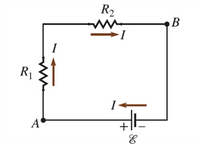Question
If the battery in the circuit below is 4.92V, resistor R1=70.84Ω, and resistor R2=69.2Ω, what is the magnitude of the potential drop across resistor R2? Please give your answer in units of Volts (V).

Transcribed Image Text:R2
B
R1
I-
A
+
Expert Solution
This question has been solved!
Explore an expertly crafted, step-by-step solution for a thorough understanding of key concepts.
Step by stepSolved in 2 steps with 2 images

Knowledge Booster
Similar questions
- Find the electric potential at points A and B for the circuit shown below. A E = 36 V battery is connected to R₁ = 502, R₂ = 15 , R3 = 25 , and R4 = 5 2. Note that point C is grounded (Vc = 0). R₁ min Ī R3 The potential at point A, VA || = The potential at point B, VB = R₂ www с B M R4 Units Select an answer ✓ Units Select an answer ✓arrow_forwardThree resistors, R1 = 17.3, R2 = 13.2, R3 = 78, are connected in series across a 16.6 V battery. What is the voltage drop (in Volts) across R1?arrow_forwardIn the figure R1 = 5.30 N, R2 = 10.24 2, R3 = 15.13 2, C1 = 5.34 µF, C2 = 10.26 µF, and the ideal battery has emf 8 = 23.1 V. Assuming that the circuit is in the steady state, what is the total energy stored in the two capacitors? R1 R3 Number Unitsarrow_forward
- Two resistors, R1 = 50 Ω and R2 = 17 Ω are connected in series to a battery providing voltage ΔVbat = 3.1 V. What is the potential difference measured across the resistor R2?arrow_forwardThe drawing shows three different resistors in two different circuits. The battery has a voltage of V = 28 V, and the resistors have resistances of R₁-50.00, R₂-25.002 and R3-10.00. Determine the current through and the voltage across each resistor. R₁ (a) ½₁ = i 12-i √3 = i V₁ = i V2= i V3-i R₁ R₂ R3 R₂ R3 (b) (a)arrow_forwardConsider the circuit, as shown in the figure above. R1 = 10.0 ohm, R2 = 11.0 ohm, R3 = 4.00 ohm, R4 = 5.00 ohm, R5 = 21.0 ohm and V = 26.0 V. Calculate the magnitude of the current in the R5 = 21.0 ohm resistor. Calculate the magnitude of the potential difference between points a and b.arrow_forward
- Problem 2: In the circuit below, AV bat = 10 V and C₁ = C₂ = C3 = C4 = C5 = 10 μF. a) What is Ceq? Answer: 16 μF. b) What is Q₁, Q2, Q3, Q4, Q5? Answers: Q₁ = 100µC, Q₂ = 20µC, Q3 = 20μµC, Q4 = 40μC, Qs = 60μC. c) What is AV₁, AV2, AV3, AV4, AV5? Answers: AV₁ = 10 V, AV₂ = 2 V, AV3 = 2 V, AV4 = 4 V, AV5 = 6 V. AV bat C₂arrow_forwardThe circuit of the figure shows a capacitor, two ideal batteries, two resistors, and a switch S. Initially S has been open for a long time. If it is then closed for a long time, what is the change in the charge on the capacitor? Assume C = 41 μF, 81 = 4.1 V, 82 = 5.3 V, R₁ = 0.520, and R₂ = 0.45 0. Number ap Units R₁ C R₂ wwwarrow_forwardThe shown circuit has been closed for a long time. Find the charge (in uC) on the 6 uF capacitor if ɛ=11 V. 6µF 50 2µFarrow_forward
arrow_back_ios
arrow_forward_ios